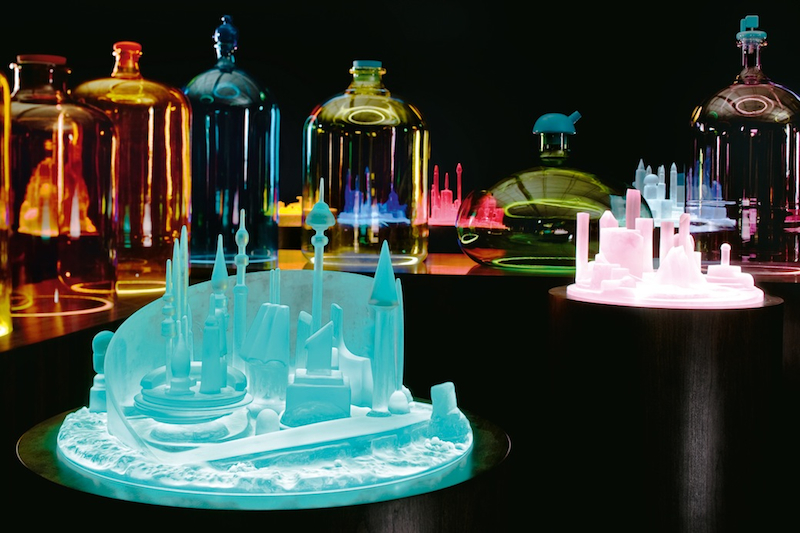
Mike Kelly, Kandors series, 1999-2011; mixed media installation; dimensions variable. Courtesy Jablonka Galerie
“Success is a lousy teacher. It seduces smart people into thinking they can’t lose.” —Bill Gates
“If you don’t fail often, you’re not trying hard enough.” —Jessica Herrin
In most aspects of our culture failure is a dirty word, one that calls up a convincing, if abstract, image of a loser—someone inept, disappointing, and weak. With its paralyzing force, the social stigma attached to failure can prevent us from taking risks. But “realistically speaking, there is no such thing as failure,” says Art21 artist Yinka Shonibare MBE. “Whenever there’s some kind of destruction or disaster, you know that it inevitably leads to another thing. Failure is just as valuable as non-failure.”1 Stories of failure resulting in triumph inspire us; they encourage us to keep going after that carrot of success. Even accounts of hopes and dreams that never came to fruition comfort us because at the very least they remind us that failing is part of being human, part of life. We all go through it.
I became interested in this theme “Failure” while I was revising a lecture on “the artist as farmer” to include The Cabbage Plot: A Community Kimchi Garden (2010) by artist Elaine Tin Nyo. Her idea for the project was to distribute cabbage seeds to friends and colleagues (including myself) and collectively we would grow a non-centralized garden of Napa cabbage. “In exchange for your efforts, I will make kimchi for you with the head you raise,” Elaine promised. My seeds were planted in a large red bucket on my kitchen windowsill. After a few successful weeks, my green sprouts had withered into a bunch of brittle needles. Dead. Very dead. I emailed Elaine, confessing that I had, not surprisingly, killed my plant. (If there is such a thing as a “green thumb,” I’m certain that I wield a “black thumb”—a digit of death.) Elaine kindly wrote back to tell me that few participants had grown their cabbage successfully; it was a bad year for the crop all around the world. I tend to connect cultivation to Eden-like images of abundant gardens and farms—the best-case scenario. But as Elaine’s project demonstrated, plants are fickle, always subject to miscarry somewhere between seed and harvest. I got to thinking, what might a series of failed agricultural projects reveal? Probably how plants mimic our own lives and creative processes. Sometimes things just don’t go the way we plan. But our failures, “flops, folds, setbacks, wipeouts, and hiccups,” are, as art historian Sarah Lewis suggests in her forthcoming book The Rise: Creativity, the Gift of Failure, and the Search for Mastery, part of, if not essential, to our growth. In other words, it’s often from our experiences with failure that we flourish. Personal failures shape our individual definitions of success and dare us to achieve it.
Artists experience and even embrace failures of all sorts, as I’ve seen in at least three exhibitions now on view in New York City. At the New Museum, Chris Burden’s documentation of Shoot (1971), in which he famously staged his own shooting, conveys the possibility of failure inherent in performance, the chance that something can go wrong in a public space. At MoMA PS1 there is Art21 artist Mike Kelley whose “art searches out dark and soiled places where defects, fault lines, and inadequacies are obvious and routine—” wrote LA Times critic Christopher Knight in 1994—“and where failure takes on the poignant, fragile, even heartbreaking beauty that accompanies any loss of self.”2 Take for example Kelley’s luminous Kandors series (1999–2011) based on the Kryptonian city of Superman’s birth and, more broadly, unrealized utopias. And then there’s the trickster René Magritte whose exhibition at the Museum of Modern Art offers another angle on failure. It has often been written that Magritte moved to Paris because of the scornful critical response to his first solo exhibition in Brussels. It was there, though, that he would become an important member of the Surrealists. What his blockbuster monograph shows us is that he eventually found success. He “failed” well.
In this sophomore issue of the Art21 Magazine our contributing writers explore the full spectrum of failure, from the artistic to the economic, the environmental to the architectural, the personal to the public. They consider how failure can be productive in classrooms; why having the freedom to fail is necessary; how viral videos present a false sense of success; the relationship between utopia and failure in architecture; how artists have responded to environmental disasters; and a basic question we all might ask ourselves when things fall apart—now what?
________
1 Quote from an Art21 interview with the artist at his London studio, October 2009.
2 Jori Finkel, “Mike Kelley Dies at 57; L.A. Contemporary Artist,” Los Angeles Times, February 2, 2012.



